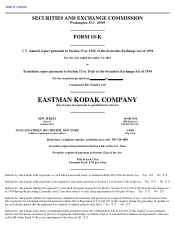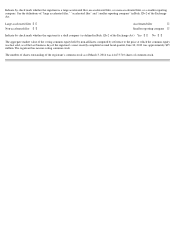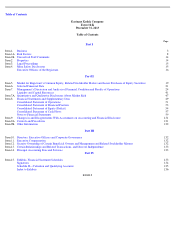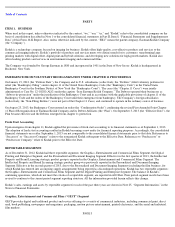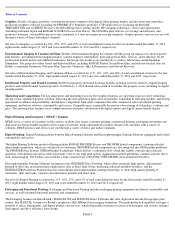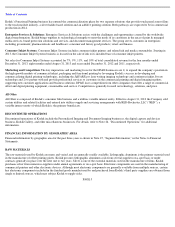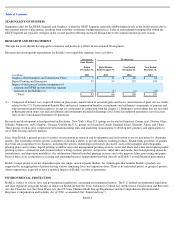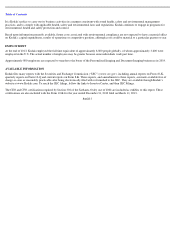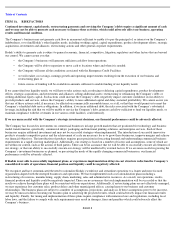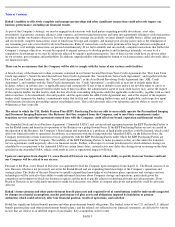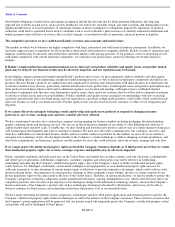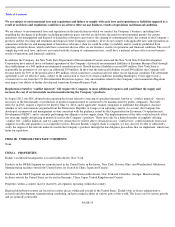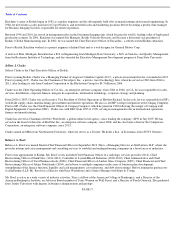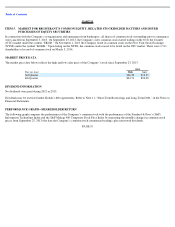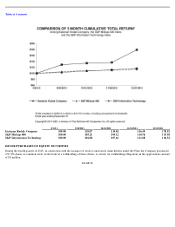Kodak 2013 Annual Report Download - page 12
Download and view the complete annual report
Please find page 12 of the 2013 Kodak annual report below. You can navigate through the pages in the report by either clicking on the pages listed below, or by using the keyword search tool below to find specific information within the annual report.
Table of Contents
these benefit obligations, funded status and expense recognition include the discount rate for future payment obligations, the long term
expected rate of return on plan assets, salary growth, healthcare cost trend rates, mortality trends, and other economic and demographic factors.
Significant differences in actual experience, or significant changes in future assumptions or obligations imposed by legislation, or pension
authorities could lead to a potential future need to contribute cash or assets to Kodak’s plans in excess of currently estimated contributions and
benefit payments and could have an adverse effect on the Company’s consolidated results of operations, financial position or liquidity.
The competitive pressures we face could harm Kodak’s revenue, gross margins and market share.
The markets in which we do business are highly competitive with large, entrenched, and well financed industry participants. In addition, we
encounter aggressive price competition for all our products and services from numerous companies globally. Kodak’s results of operations and
financial condition may be adversely affected by these and other industry-wide pricing pressures. If our products, services and pricing are not
sufficiently competitive with current and future competitors, we could also lose market share, adversely affecting our revenue and gross
margins.
If Kodak’s commercialization and manufacturing processes fail to prevent product reliability and quality issues, our product launch
plans may be delayed, our financial results may be adversely impacted, and our reputation may be harmed.
In developing, commercializing and manufacturing Kodak’s products and services, we must adequately address reliability and other quality
issues, including defects in our engineering, design and manufacturing processes, as well as defects in third-party components included in our
products. Because Kodak’s products are sophisticated and complicated to develop and commercialize with rapid advances in technologies, the
occurrence of defects may increase, particularly with the introduction of new product lines. Unanticipated issues with product performance may
delay product launch plans which could result in additional expenses, lost revenue and earnings. Although we have established internal
procedures to minimize risks that may arise from product quality issues, there can be no assurance that we will be able to eliminate or mitigate
occurrences of these issues and associated liabilities. Product reliability and quality issues can impair our relationships with new or existing
customers and adversely affect our brand image, and our reputation as a producer of high quality products could suffer, which could adversely
affect our business as well as our financial results. Product quality issues can also result in recalls, warranty, or other service obligations and
litigation.
If we cannot effectively anticipate technology trends and develop and market new products to respond to changing customer
preferences, our revenue, earnings and cash flow, could be adversely affected.
We have transformed ourselves into a technology company serving imaging for business markets including packaging, functional printing,
graphic communications and enterprise services. Our success in these businesses depends on our ability to offer differentiated solutions to
capture market share and grow scale. To enable this, we must develop and introduce new products and services in a timely manner to keep pace
with technological developments and achieve customer acceptance. We must also effectively communicate to our customers, investors, and
other key stakeholders our transformed business model, and successfully market our products for the markets we serve. If we are unable to
anticipate new technology trends, develop improvements to the Company’s current technology to address changing customer preferences, and
effectively communicate, our businesses, products, and the markets we serve this could adversely affect our revenue, earnings and cash flow.
If we cannot protect the intellectual property rights on which the Company’
s business depends, or if third parties assert that we violate
their intellectual property rights, our revenue, earnings, expenses and liquidity may be adversely impacted.
Patent, copyright, trademark and trade secret laws in the United States and similar laws in other countries, and non-disclosure, confidentiality
and other types of agreements with Kodak’s employees, customers, suppliers and other parties, may not be effective in establishing,
maintaining and enforcing the Company’s intellectual property rights. Any of the Company’s direct or indirect intellectual property rights
could, however, be challenged, invalidated, circumvented, infringed or misappropriated, or such intellectual property rights may not be
sufficient to permit us to take advantage of current market trends or otherwise to provide competitive advantages, which could result in costly
product redesign efforts, discontinuance of certain product offerings or other competitive harm. Further, the laws of certain countries do not
protect proprietary rights to the same extent as the laws of the United States. Therefore, in certain jurisdictions, we may be unable to protect the
Company’s proprietary technology adequately against unauthorized third party copying, infringement or use, which could adversely affect our
competitive position. Also, because of the rapid pace of technological change in the information technology industry, much of the Company’s
business and many of the Company’s products rely on key technologies developed or licensed by third parties, and we may not be able to
obtain or continue to obtain licenses and technologies from these third parties at all or on reasonable terms.
We have made substantial investments in new, proprietary technologies and have filed patent applications and obtained patents to protect the
Company’s intellectual property rights in these technologies as well as the interests of the Company’
s licensees. There can be no assurance that
the Company’s patent applications will be approved, that any patents issued will adequately protect the Company’s intellectual property or that
such patents will not be challenged by third parties.
PAGE 10


